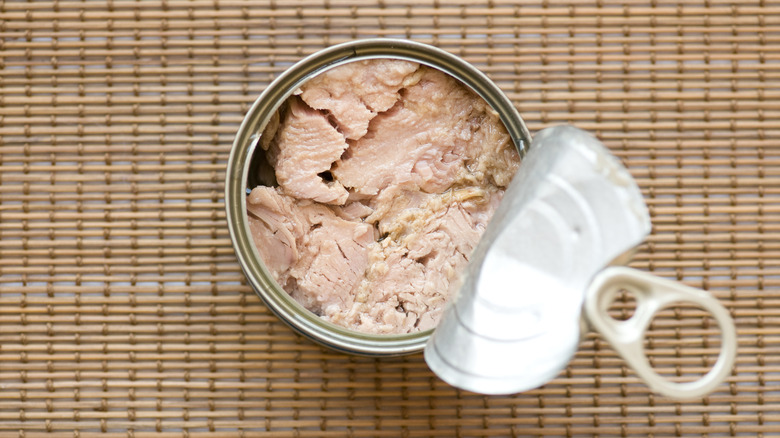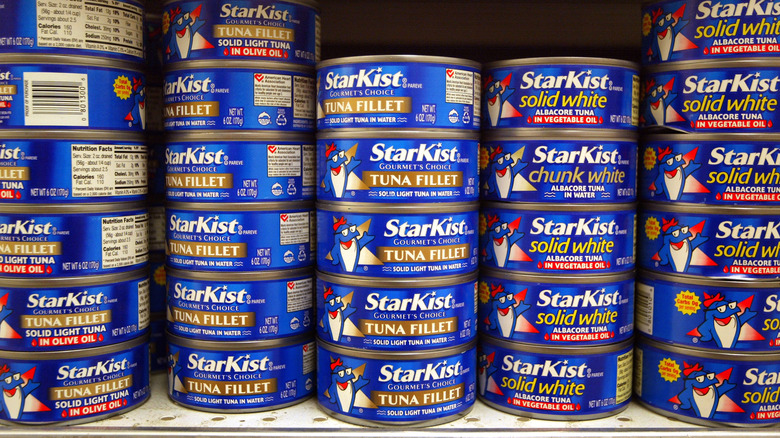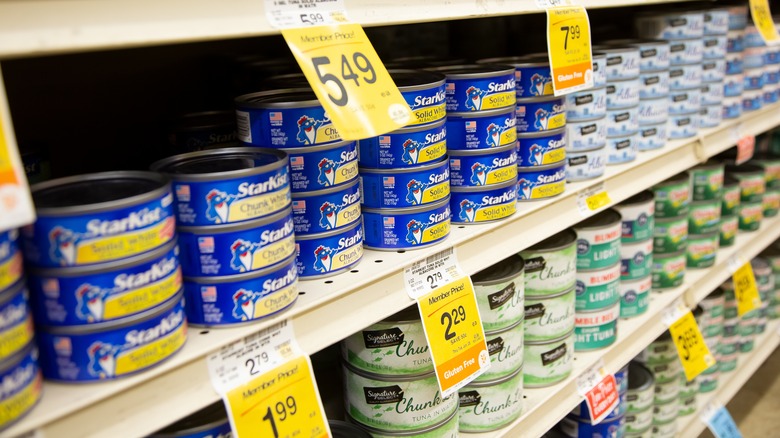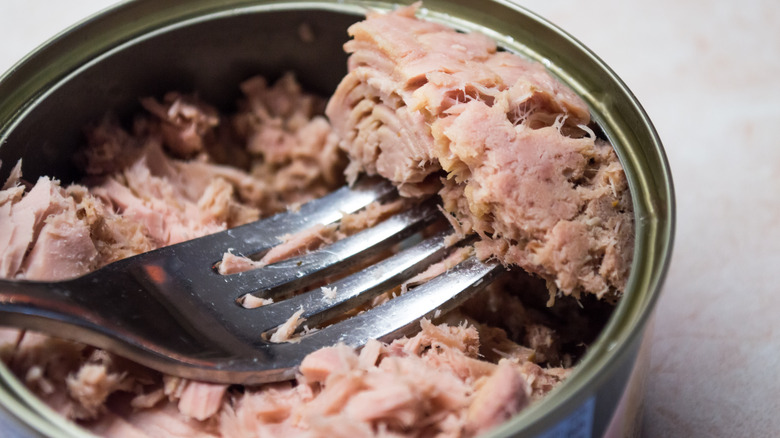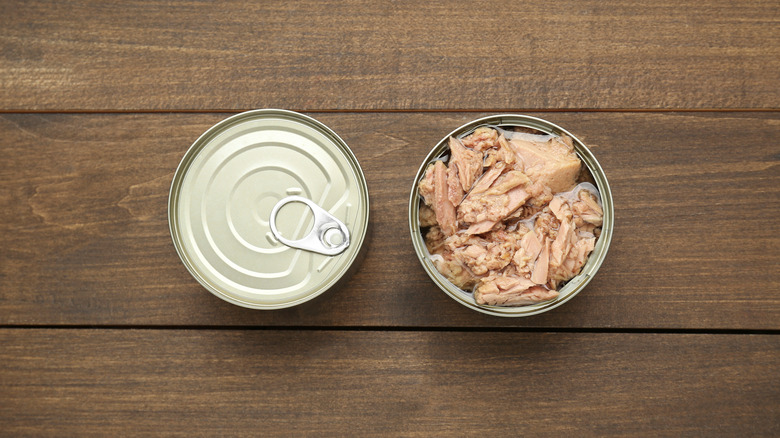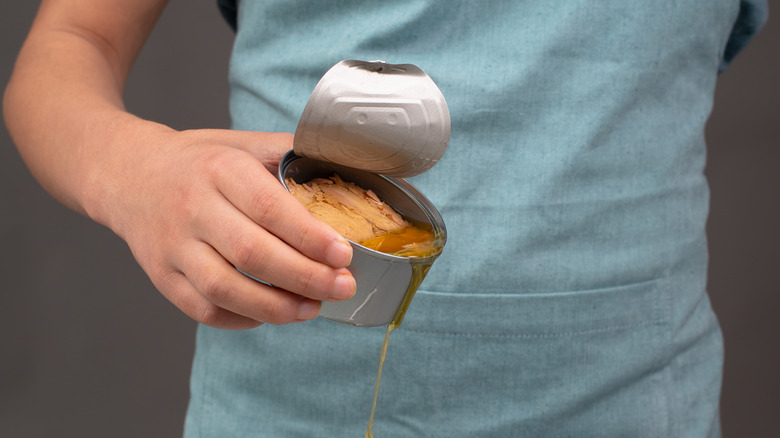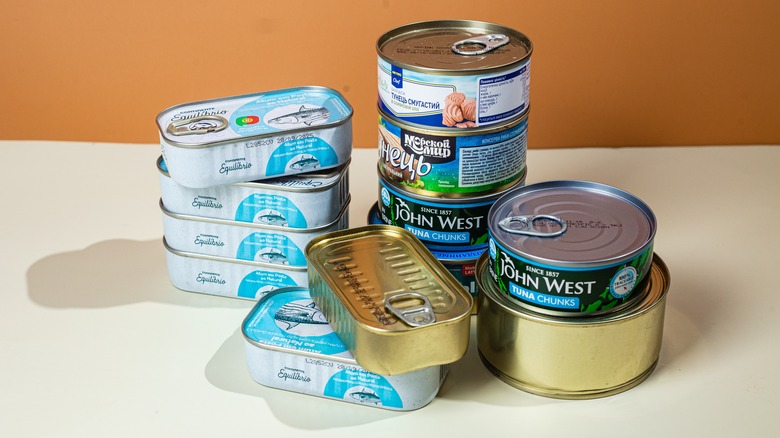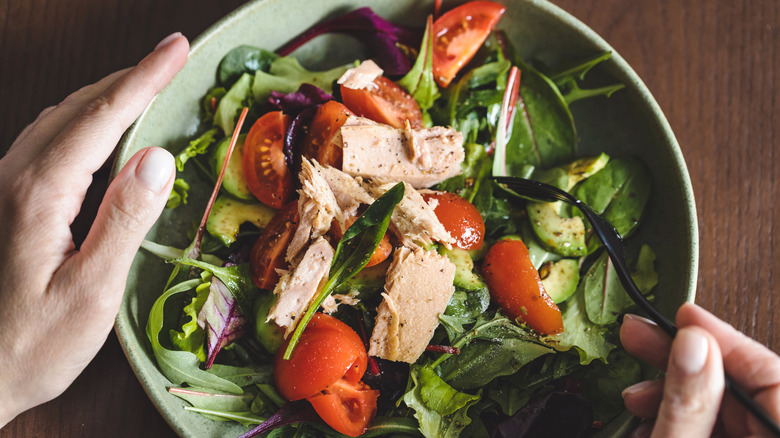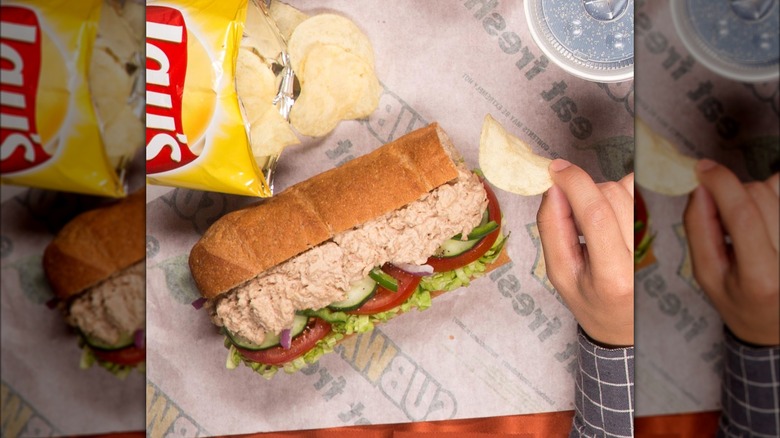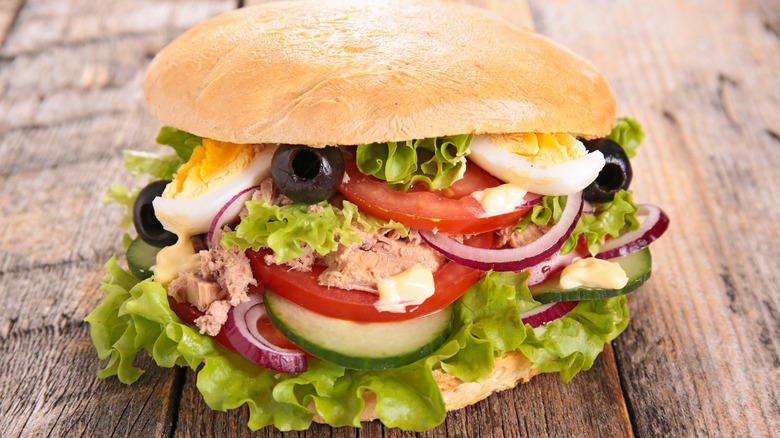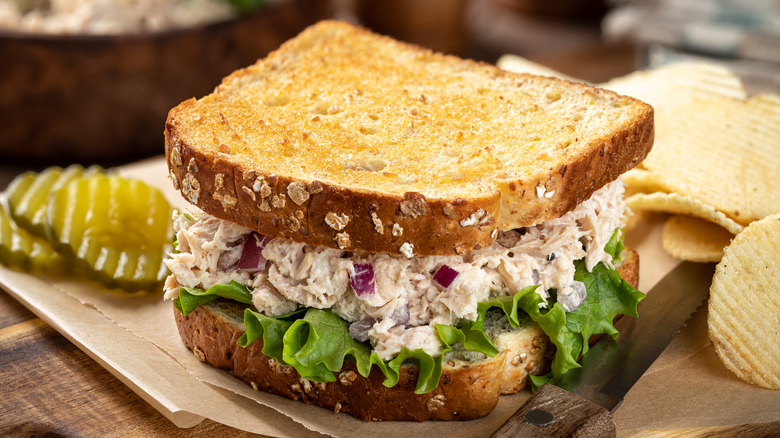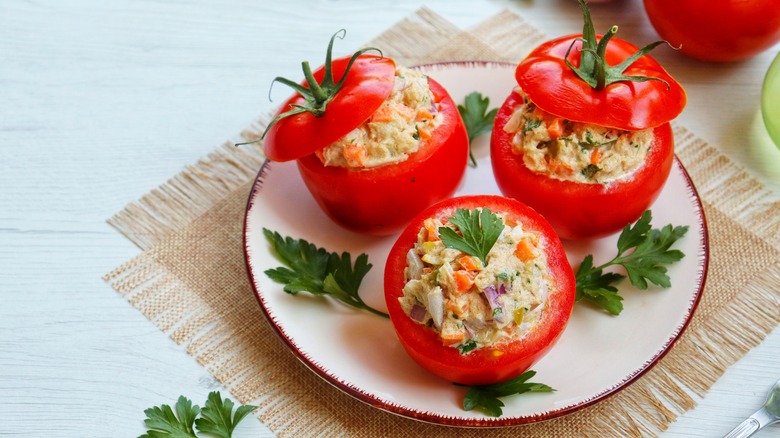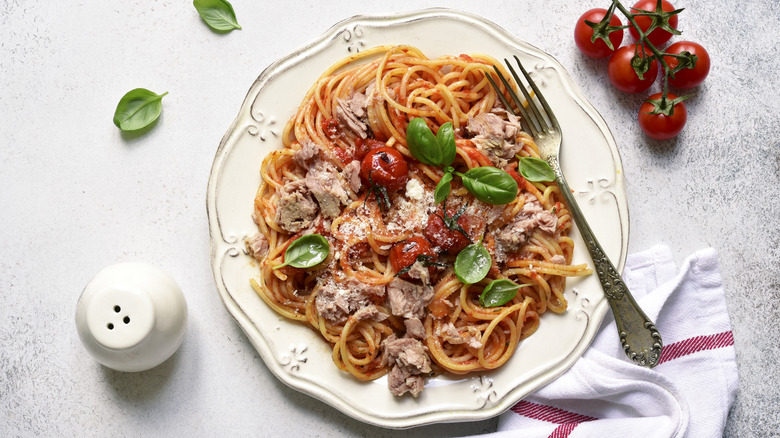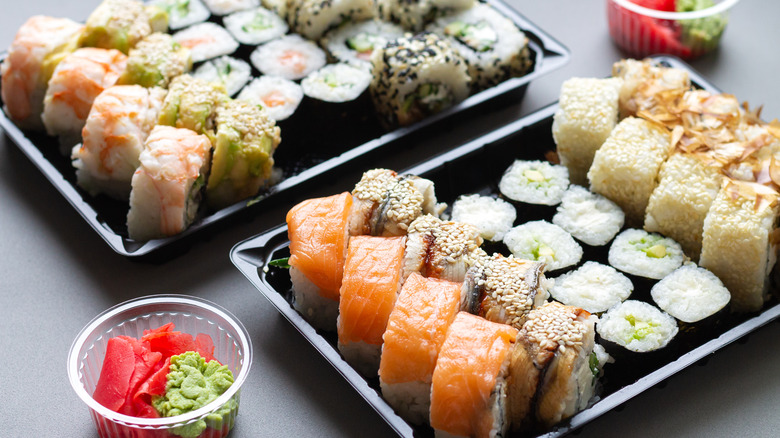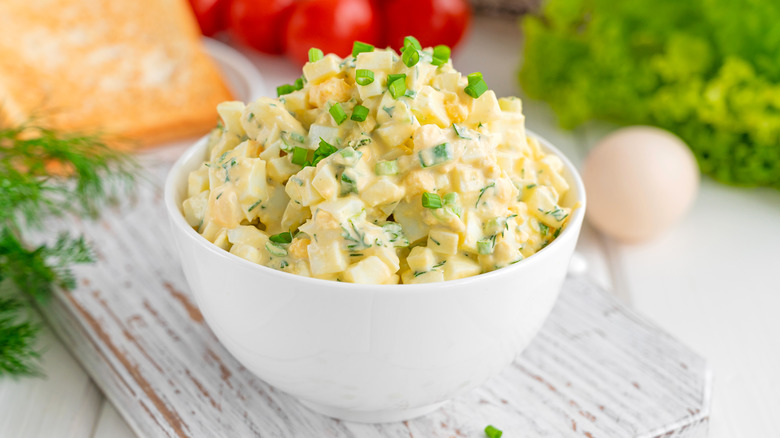Stop Making These Mistakes With Canned Tuna
While some folks may turn up their noses at the sight or smell of canned tuna, some of us have counted this item among our pantry staples for years. A can of tuna makes for a quick lunch, easy addition to a salad, or a simple snack. It's relatively affordable and comes with a lot of protein, as well as a nice serving of Omega-3s, too. It will fill you up and help you get energized and ready for the rest of your day.
But do you really know canned tuna inside and out? Or, are you making some of the most common mistakes you can make with this ingredient? You could be putting your health at risk, skipping out on top-quality tuna, or even missing out on some truly delicious canned tuna-based treats. Stop making these errors with canned tuna and enjoy all the culinary and health benefits that come with this canned fish staple.
Being unfamiliar with tuna lingo
It's important to understand what you're reading on a canned tuna label. If you don't, you could be setting yourself up for some bad canned tuna-buying decisions. Certain words and phrases on the can will clue you in to how high-quality the tuna inside is, as well as if it was sustainably-sourced or not.
Tuna caught via a pole, pole and line, or trawl are on the more sustainable side, as these methods do not result in any substantial amount of bycatch. This term refers to the amount marine life that can become accidentally entangled or caught in fishing gear. You may also look out for phrases like "FAD-free," "free school," or "school-caught," which refer to methods that also reduce bycatch. However, if these phrases aren't included, the tuna may not have been caught via these methods, and thus should be avoided.
Certain verbiage can also tell you about the type of tuna in the can. "White tuna" refers to albacore tuna, while "light tuna" can refer to a number of different species. "Chunk light" tuna is often a mix of different tunas, and some of that fish might be on the cheap, less desirable side.
Ignoring expert recommendations for the best tuna brands
If you don't consider yourself a tuna expert, either in sourcing or cooking it, you should consider taking a few tips from the pros. Don't worry — they're not going to make high-brow recommendations for brands that are totally out of your reach.
For example, Michael Feinberg, the executive chef at the Around the Clock Diner told Food Republic that he prefers white albacore tuna, canned in water. As for his favorite brands, he reaches for Bumblebee or Kirkland, from Costco. Since he's the chef at a diner, you know he knows his way around a tuna melt or tuna salad.
Another chef favorite is Korean brand Dongwon, which Momofuku founder David Chang promoted in a Facebook post. The chef, who also hosts Netflix's "Ugly Delicious," calls the brand "outrageously good." The tuna is flavored with a fermented chili paste. While Dongwon might not be familiar to the average American shopper, you might be familiar with the brand's parent company: StarKist.
Storing canned tuna in a warm area
There are certain safety precautions you have to take with storing all of your food, even if it's canned. Although you can leave some canned items in the pantry for years at a time, there are certain conditions that can make a can of tuna go bad. These include very warm spaces.
Storing canned tuna in a warm area — such as in a cabinet near the stove or oven, or in an open space that receives direct sunlight from a window — can speed up the deterioration inside of the can. This means that, regardless of what the best-by date is on the label, your tuna could be bad before you get a chance to open the can. You should also avoid storing any canned foods in damp garages or basements. Signs that your canned tuna might be bad include a leaking or bulging can, or spurting liquid or a foul odor upon opening the can.
Putting your open tuna can in the fridge
You may know that you shouldn't put unopened cans in the refrigerator, as the damp environment can cause the metal to rust. But what about an open can of food? While you might not need to eat or use an entire can of tuna at once, refrain from just tossing that open tuna can onto the top shelf of the fridge. You can keep open cans of tuna in your fridge for about three or four days before you need to toss them out. However, just because it's safe to eat the open, refrigerated tuna, that doesn't mean that its flavor hasn't changed. The tuna will likely deteriorate in flavor over those few days. Plus, the opened container leaves your tuna vulnerable to contamination.
Instead of popping the open can of tuna right in the fridge, take the extra time to transfer it into a food storage container instead. An airtight glass or plastic container is the way to go.
Forgetting to drain and rinse the tuna before use
Before you toss that entire can of tuna into a bowl of tuna salad, don't forget to both drain and rinse it. Draining is important because the liquid in the can can drastically change the texture of whatever it is you're making. Your oh-so-creamy tuna salad turns into a watery mess if you forget to drain and rinse the can's contents. Additionally, oil-packed tuna comes with a lot of fat, so draining it off can lessen the amount of both fat and calories that you end up eating.
Another reason why rinsing your tuna might be beneficial is to reduce the amount of sodium in it. According to the Journal of the American Dietetic Association, giving canned tuna a three-minute rinse can reduce the sodium content by up to 80%. This makes a significant difference if you're watching your sodium intake. A single, 3-ounce serving of StarKist chunk light tuna in water, for example contains close to 15% of your recommended daily intake of sodium.
Tossing the tuna too soon
You should throw away your opened can of tuna within four days of opening it and storing it in your fridge, and be wary of tuna that's been left in less-than-ideal storage conditions. Likewise, if the can is bulging or leaking, throw it out. However, if you've yet to open a can of tuna, the can appears in fine condition, and you've been storing it correctly in a temperature-controlled, dark, dry space, then that can of tuna might just last longer than you think. Don't make the mistake of throwing it out too quickly.
Commercially canned tuna can last up to five years in your pantry. This is just as long as any other low-acid, commercially-canned food, such as vegetables. So, while you might think that seafood, by its nature, might not last as long, don't throw out that tuna without checking the best-by date. Otherwise, you might just be throwing away perfectly fine tuna, and your money along with it.
Eating too much tuna
Tuna is typically perceived as a healthful food. It has Omega-3s, vitamins and minerals like Vitamin D and selenium, and protein. Plus, it's relatively low in calories. However, it can be too much of a good thing. If you have preexisting conditions, you may not be able to safely eat as much tuna as the average person. Canned tuna may contain a neurotoxin called mercury. In a Consumer Reports test of different products, researchers found that canned albacore tuna had up to three times more mercury in it than light or skipjack tuna. Due to the unpredictably of mercury levels, their food safety experts caution that pregnant people should consider foregoing canned tuna.
The FDA recommends that those who are pregnant or breastfeeding should only eat a maximum of two to three servings (at 4 ounces per serving) per week of canned light tuna, or a maximum of one serving of canned albacore or white tuna. As expected, children should eat less tuna than the average adult.
Not copycatting restaurant tuna salad
Some of the best tuna salad can be found at your favorite sub shops. However, if you don't feel like leaving the house or ordering delivery on a particular day, you can still enjoy your favorite restaurant tuna salad, thanks to tried-and-tested copycat recipes.
For example, if you love Subway's tuna salad, try making it home with ingredients you probably already have on-hand. Apparently, Subway's tuna salad mixture is as simple as a blend of canned tuna (Subway uses 100% wild-caught skipjack tuna), mayo, and lemon juice. From there, you can top the sub with whatever other toppings you might typically order at the sandwich shop, like lettuce and tomato.
Copying Jimmy John's tuna salad is a little more complex than Subway's rendition, but it's still relatively easy. In addition to your canned tuna, you'll need to add celery, onion, mayo, and soy sauce to your tuna salad.
Ignoring tuna sandwiches from other cuisines
When you think of a tuna salad sandwich, your mind might go directly to tuna salad on two slices of white bread. While this combination is all well and good, and a staple from many people's childhoods, don't limit yourself to just this American classic. Broaden your horizons by exploring tuna sandwiches from other countries and cuisines.
The French, for example, have a much-upgraded tuna sandwich known as pan bagnat, which literally translates to "bathed bread." Hailing from Nice, the sandwich requires you to hollow out the center of a good-quality hamburger roll. Then, you drizzle on some olive oil and vinegar before you start stacking on a host of tantalizing ingredients, including garlic, tomatoes, bell peppers, radishes, onion, fava beans, artichoke hearts, hard-boiled eggs, olives, basil, and, finally, your canned tuna. It's a smorgasbord of flavor and a far cry from a plain tuna salad on white bread.
Making a soft, mushy tuna salad
Let's face it: While tuna salad can be delicious, it can also be on the mushy side. Change all that by adding a little bit of texture to your canned tuna salad. The Takeout asked several chefs and similar experts what they add to their tuna salad recipes for texture purposes. Some of their answers might surprise you, as they're ingredients you may've never even considered pairing with tuna salad.
For example, Bryan Beneke of Hideaway Kitchen & Bar in Austin recommends adding toasted pecans, while Nick Curtola of The Four Horsemen in Brooklyn suggests lots of scallions and/or red onions. A.J. Walker of Publican Anker in Chicago, though, gave us the genius idea of adding in an ingredient you're probably already eating alongside your tuna salad sandwich: potato chips. Crush them and add them to the top of your salad before chowing down.
Not stuffing it into a vegetable
Spreading your canned tuna on a slice of bread or a cracker might be easy, but is it as good as stuffing it into a vegetable? Probably not. Consider tuna salad-stuffed tomatoes for a lighter take on a sandwich. Or you can forgo your typical ground beef-stuffed bell peppers and do as Mario Gebran of U.S. Egg told The Takeout, and stuff your tuna salad into half a bell pepper instead. Gebran also includes celery and green apple in his tuna salad, for extra texture.
Bell peppers aren't the only types of peppers that pair well with tuna, though. Mix canned tuna and anchovies with capers, black olives, and mushrooms, and then spoon the mixture into halved Romano peppers. Top them with panko and seasonings before baking. The result is a tuna and olive-stuffed pepper that makes an interesting and tasty appetizer for your next dinner party or date night in.
Leaving it out of your pasta
Ask acclaimed chefs for their favorite ways to use canned tuna and more than a few of them will tell you to add the protein to pasta dishes and sauces. For example, celebrity chef Lidia Bastianich told Tasting Table that she starts with a "basic marinara" and then adds a few extra, easy ingredients like tuna, olives, parsley, and pepperoncini, for a quick way to make a simple sauce seem just slightly fancier.
You can also add tuna to cold pasta recipes, like a tuna pasta salad, combined with crème fraîche, mayonnaise, corn, onions, and herbs and seasonings. If you do choose to combine tuna and pasta, though, a good rule of thumb is to opt for oil-based tuna in simpler pasta dishes, as the oil will add flavor, but go with water-packed tuna for dishes that include other big, pungent flavors.
Relying only on fresh or frozen tuna for at-home sushi
Some sushi recipes call for using sushi-grade fresh or frozen tuna for your at-home sushi endeavors. However, if you're a beginner and don't want to pay for that level of fish, or if you just don't prefer it, you have another option: canned tuna.
That's right. You can use canned tuna to make sushi at home. Whip up an extremely easy spicy tuna sushi roll by simply combining your canned tuna with a mixture of mayo, rice vinegar, sriracha, sesame oil, and scallions, and then rolling it alongside seasoned white rice into the nori sheets. Since learning to roll sushi at home does come with a bit of a learning curve, starting with a simple mixture like this can lower the pressure a bit and, if you mess up a few times, you won't be wasting any expensive ingredients.
Leaving it out when you make egg salad
Tuna salad, egg salad, and chicken salad are the trifecta of classic American cold sandwich salads. Let's forget about the chicken for a second, though, and remain focused on the chicken of the sea. Mixing your tuna salad with egg salad is an excellent, filling choice that will give you the best of both worlds.
Both of these salads incorporate very similar ingredients, such as a mayonnaise base. Additionally, it's not uncommon to find tuna and boiled eggs together in other recipes, such as in a Nicoise salad. So why not combine the two into one superior salad sandwich? Give the combo a little kick and make a spicy tuna and egg salad sandwich by adding sriracha, mustard, and paprika to your classic mayo. If you want to avoid making your tuna and egg salads from scratch, try combining the store-bought versions on one sub roll.
Not trying it in your rice
Sushi, rice, tuna — all of these things go together. And sushi isn't the only way to pair tuna with rice. A simple tuna rice bowl, with white rice, canned tuna, and some extra ingredients for flavor, like kimchi or sriracha, makes a perfect easy and simple lunch when you're not feeling like eating tuna with some other carb or as a sushi roll.
But what if you're not in the mood for a meal that reminds you of your last trip to the sushi bar? In that case, consider adding tuna to a Southwestern-style rice dish. When you think of tuna and Southwestern cuisine, your brain might immediately go to Cali-style fish tacos, but that's as close as you might get. But, you can also add some healthy protein to a rice-based salads, too. One good place to start is a Southwestern rice salad, where light tuna pairs well with the fresh, vibrant flavors of corn, fresh cilantro, lime, jalapeños, and tomatoes.
Never transforming your tuna into a patty
When it comes to fish-based patties, salmon patties and mackerel patties are pretty standard. However, don't let those two canned fish varieties take the limelight away from tuna. You can easily turn tuna into scrumptious patties as well, and these patties are just as versatile as the canned tuna itself.
Make a pan-fried tuna patty that channels the flavors and texture of a classic crab cake, by mixing the tuna with mayo, eggs, and panko breadcrumbs, or go for a lighter, fresh variant by using lots of dill and serving the tuna patties with a cucumber cream sauce. If you're craving something warmer, go for Spanish-inspired tuna patties with the addition of ingredients like roasted red peppers and paprika.
While tuna patties are great on their own, they also make excellent swaps for beef burger patties. Plus, making a tuna burger follows the same steps as other types of tuna patties. It really only differs on how you eat it!
Static Media owns and operates The Takeout, Mashed, The Daily Meal, Food Republic, Chowhound, and Tasting Table.
